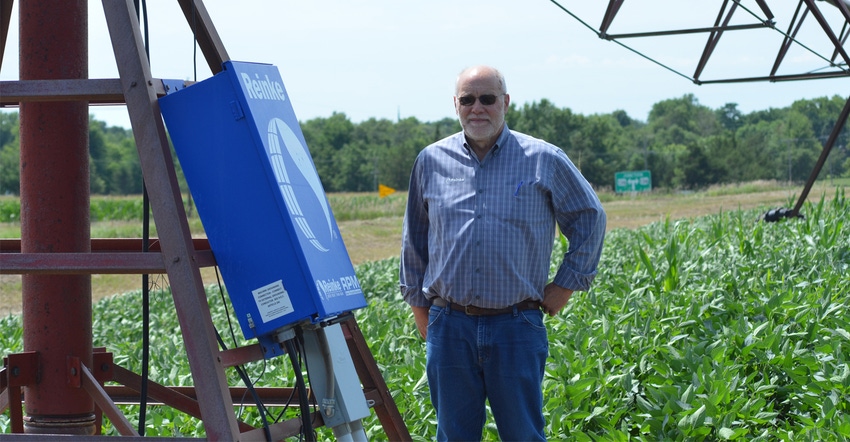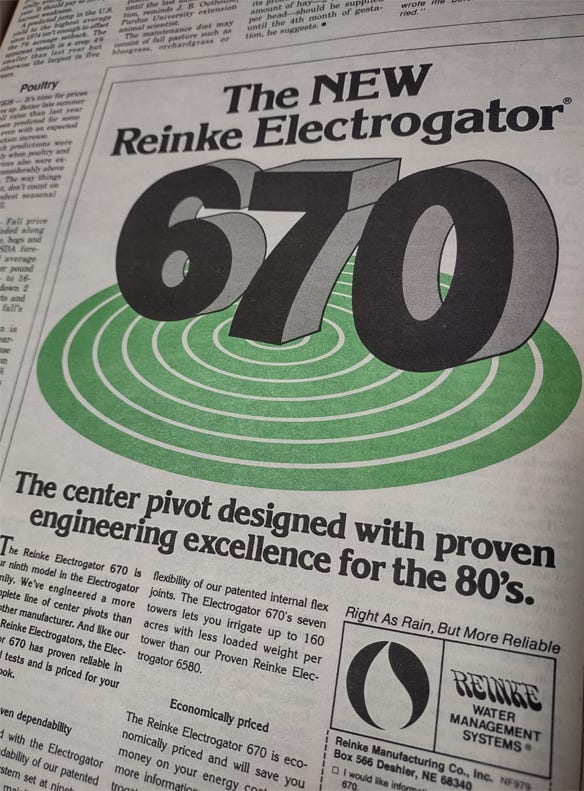
Starting out manufacturing farm and commercial building structural components in 1954, Richard F. Reinke’s company, based in Deshler, Neb., specialized in laminated rafters in those early days.
In the late 1960s, Reinke built his first center pivot, known as the Electrogator. At the time, it was the first reversible, electric-drive center pivot with a collector ring allowing continuous rotation and a span over 100 feet in length with a patented V-jack truss design.
The Reinke legacy in the irrigation business was founded on that first Electrogator. When Nebraska Farmer visited the Reinke plant in Deshler this past summer, Richard’s son Russ Reinke took a few moments to take us out in the field where Electrogator #1, that very first unit built in 1968, is still operating in a field just outside of town.
New 670
That’s why it was interesting to find an ad for the “new” Reinke Electrogator 670 on Page 9 in the Sept. 1, 1979, issue of Nebraska Farmer. Just a decade after release of the original Electrogator, the Reinke ad touted that the 670 was the ninth model in the Electrogator family.
The ad says the seven-tower units were equipped with 6-inch mainline pipe made from Cor-Ten “A” steel and the flexibility of the company’s patented internal flex joints. It said that these new units were loaded with less weight per tower than previous Reinke systems. It also called the units “economically priced” to save money on energy costs.
The Reinke story, like the stories of many of the state’s legendary agriculture and irrigation manufacturers, started with an innovative idea. His Electrogator series units were the first to incorporate interchangeable pipe and truss components, an O-ring gasket between pipes for a non-intrusive seal, and the first gear-driven towable system that had rubber tires.

NEW REINKE: This Reinke ad appeared in the Sept. 1, 1979, issue of Nebraska Farmer, touting the release of the “new” 670 Electrogator Reinke center pivot.
Russ Reinke worked for his father in the machine shop when he was young. Working for a local farmer to earn a little extra cash, Russ developed a love of farming, so he farmed with a friend through the 1980s. But the farm crisis of the ‘80s made it a tough time for agriculture in general.
Russ also worked at a manufacturing plant owned by Reinke in Geneva, Neb., where they produced oilfield pipes and casing. Working his way up to plant manager, Russ stayed with the plant even after it was sold to a Canadian steel company in the late ‘80s.
During this time, he remained involved on the board of directors for Reinke Manufacturing. But in 2006, Russ returned full time to his roots at Reinke, where he serves today as vice president and on the company board of directors.
Evolving tech
With the technological advances of agriculture and irrigation, Reinke systems have changed too since that first Electrogator and since the 670 was released in 1979. Their center pivots are operating not just in irrigation country in the U.S., but around the world. And the uses, efficiency, variable-rate control and ease that pivots can offer these days to keep crops growing continues to evolve.
While the basic concept of the Electrogator is still in the field, who knows what the future will hold as irrigation technology continues to improve?
About the Author(s)
You May Also Like






